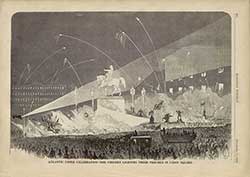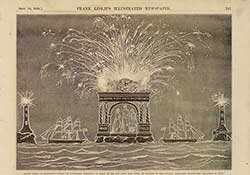
Displaced Representation and Nationalistic
Appropriation: Illustrating the Atlantic
Cable of 1858
- Mark Niemeyer
_______________________________

Fig. 42. Atlantic Cable Celebration in Union Square,
New York City, 1858 

An illustration of New York City celebrations that took place in Union Square published by Harper’s Weekly also shows numerous American flags, but what may not be obvious at first is that the central element in the image, a large equestrian statue atop an imposing base, is of George Washington, the commander-in-chief of the Continental Army during the Revolution and, of course, the first president of the United States (fig. 42). In the illustration, the statue, which had only been erected two years earlier, appears even larger than it is in reality, thus emphasizing the patriotic overtones of the depiction of the celebration. Furthermore, as many Americans at the time would have known, the statue commemorates Evacuation Day (November 15, 1783), when British troops and British Crown officials left the city at the end of the Revolutionary War, and George Washington, riding at the head of his army, made a triumphal entrance into the city, where, six years later, he would be inaugurated as the new country’s first president [13]. This example of nationalism also highlights, once again, the occasional association, either overtly or more discretely, between the nationalism linked with the Atlantic Cable project and a corresponding anti-British sentiment, which, again, tends to contradict the suggestions elsewhere that the link would strengthen Anglo-American friendship.
A final example of this phenomenon can be seen in another depiction of Atlantic Cable celebrations that appears, this time, in Frank Leslie’s Illustrated Newspaper (fig. 43). The illustration shows the grand finale of a pyrotechnic display in New York City. The illumination that is depicted below the fireworks themselves shows a triumphal arch flanked on either side by images of the two ships that laid the cable, one with an American flag and one with a British flag, and a pair of lighthouses representing the two shores where the ends of the cable were landed, also distinguished respectively by the Stars and Stripes and the Union Jack floating above them (despite that fact that, as already noted, both of the shores, at least, were British). Such equal billing for the two countries seems, once again, to reflect the sentiment of Anglo-American equality and brotherhood expressed in certain other writings and illustrations dealing with the Atlantic Cable. But such an interpretation is quickly belied by many of the details that dominate the center of the illustration. Here, it is clear that American preeminence is highlighted. If, for example, the words written across the top of the arch, “The Electric Flash Shall Belt World,” might suggest international unity, the image above the arch is dominated by an American eagle with a crown of stars and two American flags, which almost completely hide their British counterparts. The scene portrayed within the arch itself includes a similar overshadowing by American iconography in which a mythological figure (perhaps Mercury) apparently joins the hands of personifications of Great Britain and the United States, though only the representative of the United States is accompanied by an escutcheon displaying national symbols. And finally, the only two names of people that appear in the image are those of Morse and Field, offering one last example of the American dimension of the project being made to obscure the British contribution.
The success of the Atlantic Cable of 1858 clearly ignited the imagination of the general public in the United States. The popular enthusiasm it evoked was immense, as is attested by the many public celebrations, articles and poems in the popular press and two “instant books” that were published soon after the completion of the link. Illustrations formed an integral part of the presentation and celebration of the achievement in the press, and these images both supported the words written about the cable and extended their meanings, often taking on an autonomous significance of their own. The answer to the question of how exactly to illustrate the cable, however, was not necessarily obvious. Various displacement strategies were, in the end, developed in order to provide images related to this technological exploit that, in a similar fashion to the texts contained in the books, articles and poems, went beyond the cable itself. Indeed, many other subjects were represented, often reflecting the still growing cult of technology of the nineteenth century, which by 1858 had become, to a certain extent, a religion unto itself.
But the cable project was also appropriated, both overtly and covertly, for nationalistic, or indeed imperialistic, ends, and this appropriation is evidenced in the illustrations of the Atlantic Cable. That the United States was somehow in need of national unity in the late 1850s, in retrospect, seems relatively clear. For one thing, by that time, the country was about three generations removed from its founding event, the Revolution. The War of 1812, sometimes called the “second War of Independence,” however, had, in a very real sense, revived and recreated the nationalistic emotions of the Revolution, and the country was thus, from one point of view, in the hands of what Benedict Anderson refers to as “second generation” nationalists, those for whom, as he states “it was no longer possible to ‘recapture / The first fine careless rapture' of their revolutionary predecessors.” [14] This second generation, in fact, felt a pressing need to reaffirm unity through cultural nationalism, and it is not too surprising that the Atlantic Cable was made use of in this context. Furthermore, the growing sectional tensions that would lead to the outbreak of the Civil War less than three years later were already painfully apparent. And the celebration of the success of the Atlantic Cable in various ways, including through illustrations, provided both a sort of safety valve allowing the building tensions and frustrations to escape; a momentary diversion, allowing those same tensions and frustrations to be temporarily ignored; and a reassuring picture of American national unity, if only for a short while.
The revelation of rivalry between the United States and Great Britain suggested in some of the illustrations is, in the end, not too surprising either. Indeed, tensions between the two countries had never really totally disappeared since the Revolutionary War, which, again, was actually not that far in the past. The War of 1812, just mentioned, was an even closer memory. And the tensions continued. Disagreement over the Maine boundary was not settled until 1846, and the controversy over control of the Oregon Territory not until 1848. As the economy of the United States grew, the country’s problems with its former mother country continued, with conflicts arising, for example, in Hawaii, the Caribbean, Central America, China, Japan and the Red River Valley on the border between the United States and Canada. Later, with the outbreak of the American Civil War, tensions between Great Britain and the United States would rise to a new high [15]. It is these on-going conflicts that some of the illustrations of the Atlantic Cable project seem also to implicitly highlight, along with the many other dimensions of this major technological achievement of the mid-nineteenth century.
[13] George Washington was the first and only president of the United States inaugurated in New York City.
[14] Benedict Anderson, Imagined Communities: Reflections on the Origin and Spread of Nationalism, Revised Edition, London: Verso, 2006, p. 195.
[15] Great Britain remained officially neutral throughout the conflict. One major source of tension was British construction of the commerce raiders Florida and Alabama, which wreaked havoc on northern shipping.


